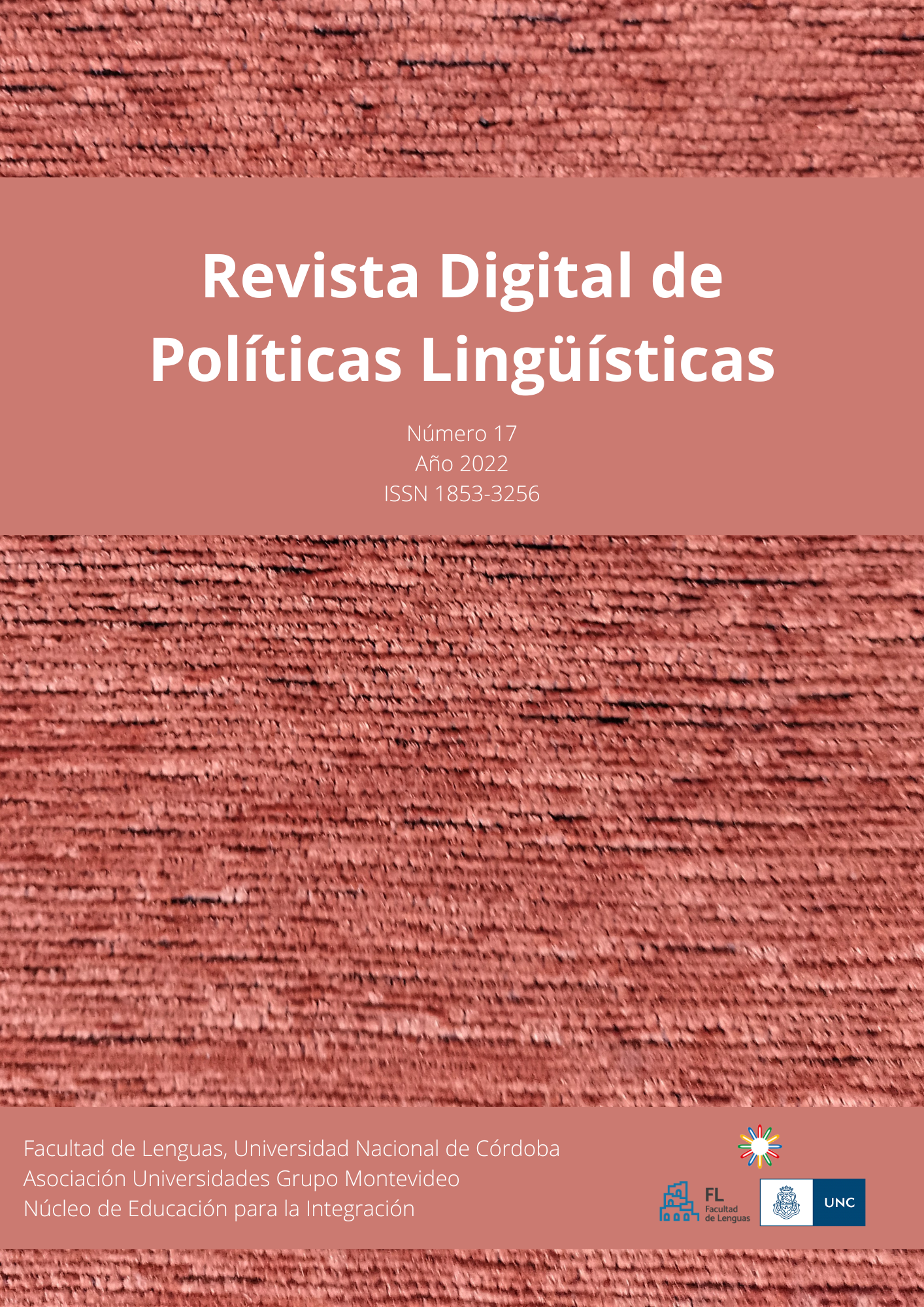Tourism and Inscriptions in Public Space: The Linguistic Landscape of Monte Hermoso Beach
Keywords:
linguistic landscape, tourism, language contactAbstract
In this paper we investigate what other languages, besides Spanish, appear in the tourist linguistic landscape of the Buenos Aires Spanish dialect region of Argentina, focusing on the public writing of the seaside resort town of Monte Hermoso.
In our analysis, we compared two sets of data collected in two different time periods: January 2020, prior to the preventive distancing motivated by the COVID pandemic situation, and January 2022, after sanitary measures became flexible. Although the results show inclusions of international languages considered prestigious in both periods, the second period presents, comparatively, a higher number of recurrences to languages other than Spanish.
References
Bonnin, J. E., & Unamuno, V. (2019). Paisajes lingüísticos latinoamericanos: razones a favor, en contra y un montón de artículos. Signo y Seña, 35, 1-6.
Duché Mónaco, L., Fernández Schmidt, A., Lasry, L., & Orsi, L. (2019). Paisaje urbano y políticas lingüísticas en Bahía Blanca (II). Distribución y uso de las lenguas preferidas en el ámbito comercial: consideraciones ideológico-lingüísticas. In L. Pérez & P. Rogieri (Comps.), Actas del IX Encuentro Internacional de Investigadores de Políticas Lingüísticas (pp. 35-42). Asociación de Universidades Grupo Montevideo-Universidad Nacional de Rosario.
Fernández Schmidt, A. (2021). Exploraciones sobre las importaciones léxicas en el español bonaerense: paisaje lingüístico y políticas implícitas. Revista Digital de Políticas Lingüísticas, 15, 82-100.
Heller, M., Jaworski, A., & Thurlow, C. (2014). Introduction: Sociolinguistics and tourism mobilities, markets, multilingualism. Journal of Sociolinguistics, 18 (4), 425-458.
Hipperdinger, Y. (2016) Importaciones léxicas en español bonaerense: compromiso fónico y convencionalización puntual. In L. Arce (Ed.), Entramados sociolingüísticos: variación, historia y comunidad (pp. 269-290). EdiUNS.
Hipperdinger, Y. (2018). Coexistencia interlingüística en un paisaje lingüístico urbano. Español y otras lenguas en denominaciones comerciales de Bahía Blanca (Argentina). Itinerarios, 27, 193-216.
Hipperdinger, Y. (2019). Importaciones léxicas y políticas implícitas: la hipercorrección como indicio. Revista Digital de Políticas Lingüísticas, 11, 54-71.
Hipperdinger, Y. (Ed.) (2019). Español y otras lenguas en el área dialectal bonaerense del español de la Argentina. EdiUNS.
Landry, R., & Bourhis, R. (1997). Linguistic landscape and ethnolinguistic vitality: An empirical study. Journal of Language and Social Psychology, 16 (1), 23-49.
Lasry, L., & Orsi, L. (2019). El paisaje lingüístico de Bahía Blanca: la presencia del inglés y del italiano en denominaciones de comercios. In Y. Hipperdinger (Ed.). Español y otras lenguas en el área dialectal bonaerense del español de la Argentina (pp. 165-178). EdiUNS.
Maly, I., & Blommaert, J. (2019). Digital Ethnographic Linguistic Landscape Analysis (ELLA 2.0). Tilburg Papers in Culture Studies. Paper 233.
Martínez Ibarra, F. (2016). Spanish and Valencian in contact: A study on the
linguistic landscape of Elche. In S. Sessarego & F. Tejedo-Herrero (Eds.), Spanish Language and Sociolinguistic Analysis (pp.135-153). John Benjamins.
Pons Rodríguez, L. (2011). Hispanoamérica en el paisaje lingüístico de Sevilla. Itinerarios, 13, 97-127.
Regalado Aragón, M. (2013). El consumo turístico en destinos litorales. Estudio de caso Monte Hermoso. Tesis de Licenciatura, Departamento de Geografía y Turismo, Universidad Nacional del Sur.
Sharma, B. (2021). Language, Ethnicity, and Tourism in the Making of a Himalayan Tamang Village. In J. E. Petrovic & B. Yazan (Eds.), The Commodification of Language: Conceptual Concerns and Empirical Manifestations (pp. 108-126). Routledge.
Srhir, A. (2019). Dos décadas de estudios del Paisaje Lingüístico: enfoques teórico-metodológicos y nuevos desafíos en la investigación. Signo y Seña, 35, 7-26.
Sung-Yul Park, J., & Wee, L. (2022). World Englishes and the Commodification of Language. In T. Rubdy & R. Tupas (Eds.), Bloomsbury World Englishes Volume 2: Ideologies (pp. 64-80). Bloomsbury Academic.
Winter-Froemel, E., & Onysko, A. (2012). Proposing a pragmatic distinction for lexical Anglicisms. In C. Furiassi, V. Pulcini & F. Rodríguez-González (Eds.), The Anglicization of European Lexis (pp. 43-64). John Benjamins.
Downloads
Published
Issue
Section
License

This work is licensed under a Creative Commons Attribution-NonCommercial-NoDerivatives 4.0 International License.
Aquellos/as autores/as que tengan publicaciones con esta revista, aceptan los términos siguientes:
- Los/as autores/as conservarán sus derechos de autor y garantizarán a la revista el derecho de primera publicación de su obra, el cual estará simultáneamente sujeto a la Licencia de reconocimiento de Creative Commons que permite a terceros compartir la obra siempre que se indique su autor y su primera publicación esta revista.
- La cesión de derechos no exclusivos implica que la publicación de los artículos en la presente revista no quita la posibilidad o el derecho al autor de publicar de manera posterior a otras revistas u órganos editoriales y la autorización por parte de los autores para que el trabajo sea depositado en los repositorio institucionales: Portal de Revistas de la Universidad Nacional de Córdoba.



